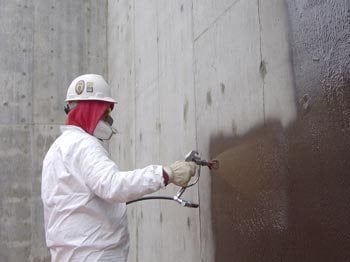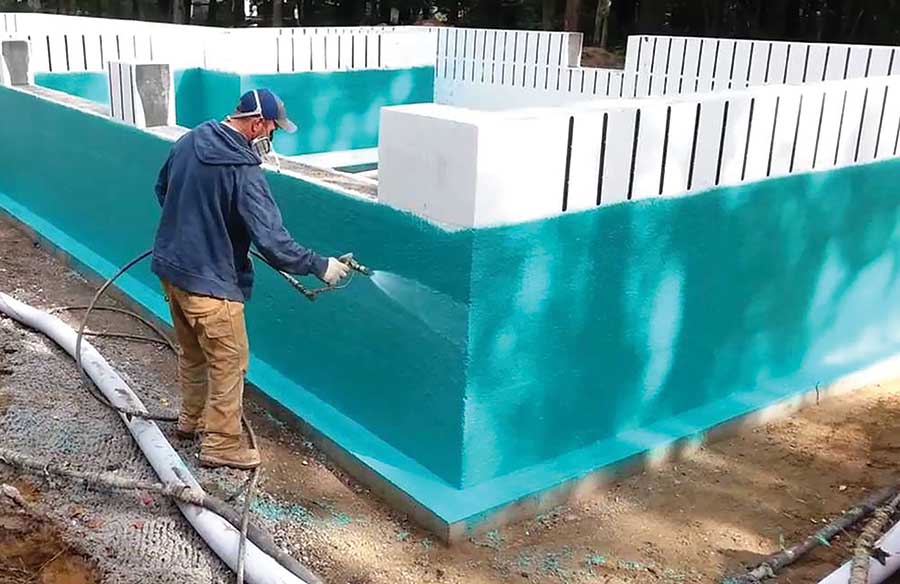Exactly How Waterproofing Functions: A Thorough Consider Strategies and Technologies
Waterproofing is necessary for shielding frameworks from moisture-related damage. It entails different methods and technologies that develop barriers versus water intrusion. Standard methods, such as compressed clay, coexist with contemporary developments like liquid-applied membrane layers. Recognizing the subtleties of these methods is essential for efficient application. The performance of any kind of waterproofing option pivots not only on the techniques utilized but likewise on ongoing upkeep and assessment. What are the crucial variables that influence long-term efficiency?
Comprehending the Fundamentals of Waterproofing
Waterproofing is an important procedure that secures frameworks from water intrusion, which can result in significant damage in time. This method includes the application of different materials and strategies created to develop an obstacle against moisture. The main goal is to avoid water from passing through surfaces, which can create degeneration, mold and mildew development, and structural instability.Various aspects affect the selection of waterproofing technique, including the kind of framework, its place, and ecological problems. Understanding the physics of water movement and the properties of different materials is vital in selecting an effective waterproofing solution.Effective waterproofing not just safeguards buildings however also enhances their long life and integrity. Normally, it is integrated into the design phase of building to ensure comprehensive defense. As understanding of water-related concerns expands, the significance of recognizing waterproofing basics comes to be significantly clear to engineers, building contractors, and residential property proprietors alike.
Standard Waterproofing Approaches
Conventional waterproofing approaches have actually been utilized for centuries, depending on tried and true strategies and materials to protect structures from water damages. One of the earliest techniques includes the use of clay, which, when compressed, produces an all-natural barrier versus wetness. Additionally, asphalt, a sticky, black material originated from petroleum, has actually been employed for its water-resistant homes, often put on roof coverings and foundations.Another method includes the application of lime-based plasters, which give a breathable layer that enables moisture to run away while preventing water access. Thatch roof covering, a typical method still seen in some societies, offers exceptional waterproofing due to its securely packed straw layers.Moreover, using stone and brick has projected, as these materials are inherently resistant to water when correctly mounted. Generally, traditional waterproofing techniques highlight the value of selecting ideal products and building techniques to enhance toughness versus water intrusion.
Modern Waterproofing Technologies
Advancements in contemporary waterproofing technologies have actually transformed the method structures are shielded from water damage. Ingenious methods such as liquid-applied membranes and advanced sealers have actually enhanced the efficiency and flexibility of waterproofing solutions. These technologies permit seamless application, decreasing the danger of leaks and making certain complete protection over complex surfaces.Moreover, the assimilation of smart modern technologies, such as dampness sensors and automated monitoring systems, allows real-time assessment of waterproofing efficiency. This proactive strategy helps with timely upkeep and minimizes long-lasting repair costs.Additionally, improvements in spray-applied coverings use fast application and exceptional attachment, adapting to numerous substratums while offering robust security. Strategies like polymer-modified systems better improve adaptability and sturdiness, making them appropriate for varied environments. Generally, modern waterproofing innovations not just reduce water breach but likewise add to the long life and sustainability of frameworks, noting a substantial shift in the sector.
Materials Utilized in Waterproofing
The performance of waterproofing solutions greatly depends on the materials used in their application. Different materials are employed to create obstacles against water ingress, each with special homes fit for different settings. Typically used materials include membrane layers, finishes, and sealants.Liquid-applied membranes, frequently made from polyurethane or acrylic, create a smooth barrier that adapts to intricate surface areas. Sheet membrane layers, typically constructed from rubber or polycarbonate, offer sturdiness and are suitable for bigger areas. Additionally, cementitious waterproofing materials, composed of cementitious substances, provide outstanding adhesion and flexibility.Sealants made from silicone or polyurethane are essential for joints and joints, making sure comprehensive security. Additionally, advanced products, such as geo-composite membrane layers, integrate multiple features, improving efficiency. In general, the option of waterproofing materials is crucial in achieving lasting and reliable water resistance, tailored to particular project demands and ecological conditions.
Typical Applications of Waterproofing
Waterproofing plays an important duty in various markets, guaranteeing the durability and stability of frameworks. Usual applications include household remedies that secure homes, business infrastructure that safeguards businesses, and commercial settings that need robust security against moisture. Recognizing these applications highlights the value of waterproofing in you can try this out keeping both security and functionality throughout various atmospheres.
Residential Waterproofing Solutions
Lots of homeowners face obstacles with moisture intrusion, making efficient household waterproofing More Info services crucial. Numerous approaches exist to resolve this problem, consisting of inside and exterior waterproofing systems. Interior solutions often entail the application of sealers and coverings to cellar walls, which assist stop water seepage. Exterior techniques generally include the installment of drain systems and waterproof membranes that divert water far from the foundation.Additionally, home owners might think about sump pumps to eliminate water accumulation and dehumidifiers to regulate humidity degrees. Appropriate grading and making use of gutters likewise play an essential role in handling water circulation around the home. By implementing these approaches, home owners can significantly decrease the risk of water damage and mold and mildew growth, making sure a completely dry and safe living environment.

Business Facilities Protection
Efficient waterproofing options play a crucial duty in the security of business facilities. Basement waterproofing Omaha. These methods are crucial for securing structures, parking frameworks, and bridges from water damage, which can endanger architectural honesty and bring about pricey repair work. Usual applications include the installation of membranes, finishings, and sealers that create obstacles against moisture infiltration. Locations such as basements, roofing systems, and exterior wall surfaces are typically focused on to assure longevity and longevity. Furthermore, waterproofing systems can boost energy performance by preventing water-related issues that might lead to mold and mildew development and degeneration. By carrying out robust waterproofing steps, home proprietors can shield their investments and maintain functional efficiency, eventually contributing to the total sustainability of business facilities
Industrial Applications Overview
While different fields encounter special difficulties, the demand for reliable waterproofing services stays a continuous in industrial applications. Industries such as manufacturing, construction, internet and energy often experience settings where moisture exposure can threaten structural integrity and operational effectiveness. In producing facilities, waterproofing is important for safeguarding equipment and materials from water damages. In building, it safeguards structures and cellars against groundwater infiltration. The power industry relies on waterproofing for the protection of devices in hydroelectric plants and offshore frameworks. In addition, food processing industries make use of waterproofing to guarantee health and compliance with safety criteria. In general, reliable waterproofing services are vital for improving durability, security, and performance throughout various commercial settings.
Maintenance and Long Life of Waterproofing Solutions
Although waterproofing services are created to use long-lasting protection versus dampness breach, routine upkeep is necessary to guarantee their effectiveness and durability - Sump pump discharge drainage Omaha. Regular examinations play a substantial duty in determining potential problems such as cracks, peeling off, or signs of water damage. Dealing with these issues immediately can protect against further deterioration and pricey repairs.Additionally, cleaning the surface of waterproofed areas aids get rid of dirt and debris that might jeopardize the honesty of the waterproofing obstacle. It's also recommended to reapply protective coatings or sealers as suggested by producers to maintain suitable performance. Ecological variables, such as UV direct exposure and extreme weather condition problems, can affect the life-span of waterproofing products, making regular analysis essential
Frequently Asked Inquiries
Can Waterproofing Be Applied in Winter?
The question of using waterproofing in winter elevates concerns about attachment and treating. Numerous products might not do at their best in reduced temperatures, necessitating mindful choice and consideration of certain standards for efficient application.
Just How Lengthy Does Waterproofing Normally Last?
The period of waterproofing effectiveness differs based upon materials and environmental elements. Typically, it can last from five to 10 years, yet normal upkeep and assessments are important to assure peak performance and durability.
Is Do It Yourself Waterproofing Effective and Safe?
The efficiency and security of DIY waterproofing depend on numerous elements, consisting of worldly quality and application technique. While some individuals achieve satisfying outcomes, others may encounter issues that jeopardize long-term security and architectural honesty.
What Are the Signs of Failing Waterproofing?
Signs of falling short waterproofing include visible water stains, peeling off paint, mold development, musty smells, and dampness in wall surfaces or ceilings - Water Solutions. These indications recommend jeopardized barriers, necessitating punctual examination and possible remediation to avoid further damages
Just how Do I Select the Right Waterproofing Specialist?
